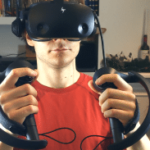As we laid out in our review last month, the new HP Reverb G2 is an incredible VR headset. But its controllers? Not so much.
The newly-redesigned Windows MR controllers are a definite improvement over the originals, but they’re still a little awkward to hold and, crucially, struggle in the tracking department. In our video review, you can see the controllers fighting to be noticed when held at waist-height. It’s troublesome enough to make the G2 difficult to recommend to hardcore VR players that favor faultless tracking above all else. What if, then, you could swap over these devices with another set of controllers tracked by Valve’s ever-stable Lighthouse tracking system?
Enter the Valve Index Controllers.
Yes, it is indeed possible to mix and match and get Valve’s latest designs up and running on G2. Successfully doing so results in probably the best PC VR experience you can have today. But, the hoops you’ll have to jump through ultimately offset how viable this approach is.
For starters, the Reverb G2 is in itself a $600 purchase but the Index controllers, too, are far from cheap, coming in at $270 if you get them separately. Then you’ll need base stations, which cost around $150 each. Even then, though, you’re not done; the Index Controllers require some sort of receiver to pair up with your PC. You could use the dongles that come with the Vive Tracker pucks, though those start at $100. Some third-party companies do sell the dongle independently, including Tundra Labs for $29 though it says stock won’t be back until January 2021. If you have an old SteamVR headset lying around, like the original Vive or an Index, though, you can use that.
So in a best-case scenario, you already have a full Index kit ($1,000) and can get the G2 ready to go. But if the G2 is your first VR headset since the Vive, you’re looking at a starting price of $870 for the headset and controllers. If you don’t have a Vive or any other SteamVR kit, we’re talking a minimum of around $1,150. Yikes.
By now it should be clear that this solution is only for the most enthusiastic of VR enthusiasts, then. Note that that is only $40 more than the full Index kit though so, if you were considering picking that up, you might want to investigate this alternative, convoluted as it may be.
Once you’ve procured every item, setting things up isn’t too much of a jumble. You’ll need the OpenVR Space Calibrator software and then have to sync the controllers together inside SteamVR (full instructions on setting up can be found here). Turn your original Windows VR controllers off (hopefully forever) and that should pretty much be it.
It’s a hassle to get through but, if you’re dedicated, it makes a world of difference to the Reverb G2 experience. Not only could I play games with precision, pitch-perfect tracking and unbeatable clarity, but this also gets you access to a handful of other games, like the incredible Aperture Hand Lab, and the ability to, uh, crush cans in Half-Life: Alyx. If you’re the type that’s got a dedicated VR space that’s ready and waiting for every incremental update to your setup, this is definitely something you’ll want to take notice of.
But consider a few things. First, if you’re using an Index or Vive as a receiver, good god does it make for a righteous mess. One VR headset’s cables is more than enough for most people, let alone two. And don’t forget that this solution robs you of one of the Reverb G2’s key features, inside-out tracking that’s completely free of external markers and sensors. Granted that tracking is troublesome to begin with, but it definitely detracts from the accessibility factor.
A heck of a lot of caveats, then, but if you have the money, space and patience to deal with them, the HP Reverb G2 with Index Controllers offers the best consumer VR experience on the market today. Now, if only we could get a wireless adaptor.







